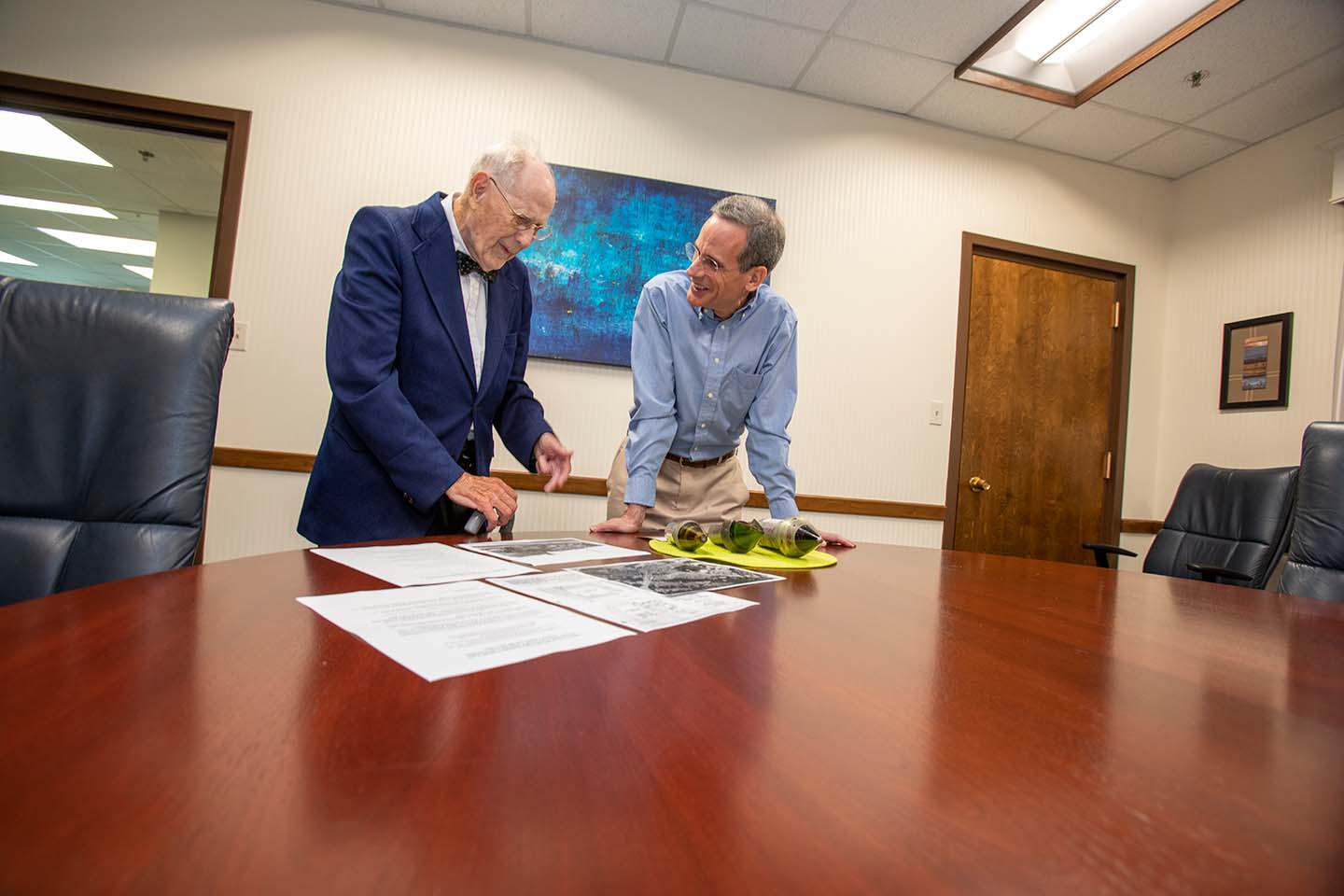Press Release
The Homecoming of a Century
Original Johns Hopkins APL Staff Member Returns to Mark 100th Birthday
It had been 45 years since Ken Dyer walked the halls at Johns Hopkins Applied Physics Laboratory, yet time hadn’t dimmed the centenarian’s memories of the place. Dressed in a navy sports coat, slacks and a bow tie, Dyer — an original Lab staff member who began working on the VT fuze in July 1941 — headed down the main hallway of Building 1 last Friday morning and turned left.
“My office was right down this way,” Dyer said, gesturing to the west wing of the Lab’s first Howard County building. As he boarded a shuttle and descended the hill toward the Central Green, he looked around in awe.
“One of the buildings down here was the barbershop,” he said, motioning toward Building 13, “And this [the Central Green] was all Butler Buildings. Looks quite different today!”
Dyer, who turned 100 years old on June 24, is an APL “plank owner,” a term given to those who were a part of the Lab at its inception. Migrating to Silver Spring from his job in a Maine paper mill in the summer of 1941, he was responsible for getting the original machine shop up and running. He rattles off the address of APL’s first residence — a converted auto garage at 8621 Georgia Avenue — with ease.
“See,” he told APL Director Ralph Semmel in a private meeting as the two looked at photographs of that building, “this was just two floors. There was a third floor put here, and then an addition along this side for half a block, and that was three stories.
“It brings back memories, I’ll tell you. At the time, it was just a temporary thing. ‘Come in for the war, and you’ll go home.’ Seven thousand people now? Oh boy. And I was badge No. 48. Started out with one little old project!”
Dyer, a machinist who went on to become an engineer and retired in 1974 as an assistant group supervisor in the Fleet Systems Department, was invited back to the Laurel, Maryland, campus in honor of his centennial milestone. On a tour that also included Dyer’s son, David, and his grandson, Donald Strobel — all of whom are retired — current staff members got a chance to say “thank you” to one of the men who made what all APLers do today possible, and show him just how far things have come.
“We wouldn’t be here today without you,” Semmel told Dyer. “It’s folks like you who set the stage for the rest of us.”
Dyer toured the Mechanical Fabrication Facility and the Intelligent Systems Center during his visit, commenting often on how impressive the work being done now seemed. “It’s a different world,” he said, shaking his head. Paul Biermann, a master inventor and materials and process engineer in the Research and Exploratory Development Department, gave Dyer the tour of Building 15 himself, and asked for Dyer to autograph his replica VT fuze.
The Dyers, who moved to Rohrersville, Maryland, 26 years ago, have five generations of their family currently living, with Ken as the family patriarch. His wife, Virginia, died 11 years ago at 91; they have two children (David Dyer, also an engineer, and Pauline Strobel) and 11 grandchildren, but the math gets a little fuzzy on the number of great grandchildren and great, great grandchildren. “I’ve lost count,” Donald Strobel admitted.
While Dyer started as a machinist, working on APL’s first defining innovation, the VT fuze, he attended college at night to earn his engineering degree. “There were 24 hours in a day and I used all 24 of ‘em,” he quipped. In addition to the fuze, he also worked on the Terrier missile and other major Lab projects during his more than 30-year tenure.
Dyer retired at age 55 and planned to drive all over the United States in a recreational vehicle with his wife, but they had reached the Rio Grande when their trip was interrupted by a family emergency. By the time they’d returned home things had calmed, but, Dyer said “we never did get back to it.”
He did, however, manage to find his way to all 50 states, accomplishing his goal of photographing each state capital.
Dyer credits his longevity to “the grace of God, I guess,” and notes his mother lived to be 103. His son and grandson were also quick to point out he is a man of routine — breakfast at 8 a.m., lunch at noon and dinner at 5 p.m. every day. His love of TV dinners (at least since his wife passed) and McDonald’s cheeseburgers have sustained him. And he's still active; his children even caught him shoveling snow last year, though they threatened death if he were to ever try that again.
“He’s completed everything he’s ever wanted to do,” Strobel said. “For all his children, his grandchildren and so on, he’s always been there for anything we need. He’s always the first one to lend a hand.”
At the end of Dyer’s tour, Semmel presented him with an original copy of the fuze poster that hangs outside of Parsons Auditorium, signed by the Lab staff members who worked on that critical contribution. “I suspect my name is on there somewhere,” Dyer said. “I spent many a night on those fuzes, burning the midnight oil.”
He summed up his visit noting there’s little comparison between the Lab then and now.
“The immensity of it now is just way beyond," he said. “I hope it continues. Anybody who’s ever been through here realizes the importance of the work you do.”
